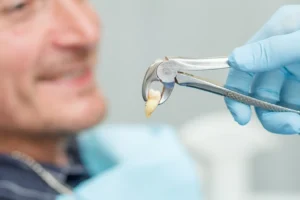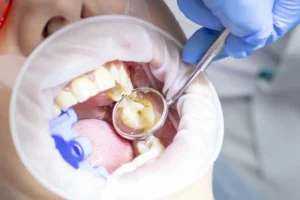Table of Contents
Tooth pain can stop your day in its tracks. If you’re dealing with a deep infection or a tooth that zings with hot, cold, or pressure, a root canal might be the best way to save the tooth and finally feel relief. Dr. Low provides clear guidance, gentle treatment, and options to help you stay comfortable from start to finish.
Below, you’ll learn when a root canal is recommended, how the procedure works, what recovery looks like, and why a dental crown often follows to protect your tooth for the long term.
What Is a Root Canal—and Why It’s Done
A root canal removes inflamed or infected tissue from inside the tooth, cleans and disinfects the canals, and seals the space so bacteria can’t return. It’s recommended when decay or infection reaches the pulp (the tooth’s nerve/blood supply) and causes lingering pain, temperature sensitivity, or tenderness to chewing. Treating infection early helps you avoid extraction, which can lead to shifting teeth and bone loss.
1) A Root Canal Can Save Your Natural Tooth
When the inner tissue is infected, you have two main paths: treat the infection (root canal) or remove the tooth (extraction). Saving the tooth helps maintain your natural bite, protects neighboring teeth from drifting, and preserves bone. Extraction may still be appropriate in specific cases, but many patients are happiest when they can keep their own tooth.
2) Common Signs You Might Need a Root Canal
These signs suggest it’s time for an exam with Dr. Low:
- Lingering pain after hot, cold, or sweet foods
- Sharp pain when biting or chewing
- A pimple-like bump on the gums near the tooth
- Darkening of the tooth or gum tenderness
- Swelling in the gum or face near the tooth
Only a dentist can diagnose the cause—sometimes the fix is simpler than you expect.
3) The Procedure is Straightforward
Here’s what typically happens at Billings West Dental:
Exam and imaging
We confirm the diagnosis with an exam and X-rays, review your health history, and discuss your options and timeline.
Comfort first
The tooth and surrounding area are thoroughly numbed with local anesthetic so you stay comfortable throughout.
Cleaning the canals
Dr. Low makes a small opening in the tooth, removes inflamed or infected tissue, gently shapes and disinfects the canals, and places medication as needed to encourage healing.
Sealing the tooth
Once clean, the canals are filled and sealed to block bacteria. A temporary or intermediate restoration is placed to protect the tooth until the final crown visit.
Patients are often surprised by how routine this feels—many compare it to getting a longer filling.
4) Conscious Oral Sedation Is Available if You’re Anxious
If dental visits make you nervous, we offer conscious oral sedation to make treatment easier:
- You take a prescribed medication at our office before your appointment
- You remain awake but feel deeply relaxed and at ease
- You’ll need a driver to and from your visit for safety
- Feeling drowsy afterward and remembering little of the appointment are both common
Ask us about sedation during your consultation—we’re happy to help you choose what feels right for you.
5) Expect a Crown to Protect the Tooth Afterward
After a root canal, the tooth is clean and free of infection—but it can be more brittle. A dental crown is commonly recommended to strengthen and protect it for everyday chewing. At Billings West Dental, your crown is custom-made to match your natural teeth in color and shape, usually completed over two visits (prep/impressions, then final placement).
6) Recovery is Usually Quick and Manageable
Most patients return to normal routines the same day or the next. A few tips:
- Mild soreness is normal for a day or two; over-the-counter pain relievers usually help
- Chew on the opposite side until your final crown is placed
- Brush and floss as usual, taking care around any temporary filling or crown
- Call us if pain worsens after day two, swelling increases, or your bite feels high
7) Root Canal vs. Extraction + Replacement
Sometimes people ask, “Why not just pull it?” Extraction can be appropriate, but it often leads to a second decision: replace the tooth (with an implant, bridge, or partial denture) or live with the gap. Replacement adds time, care steps, and cost. When feasible, saving the tooth with a root canal and crown is typically simpler and maintains your natural bite.
Step-by-Step: Your Visit with Billings West Dental
Consultation and planning
We review symptoms, take imaging, and confirm whether a root canal is the best solution for your case.
Treatment day
Local anesthetic, careful cleaning and disinfection, sealing the canals, and placing a temporary or core build-up.
Follow-up and crown
Once comfortable, we prepare the tooth for a custom crown, take impressions, and place a temporary. At your next visit, your final crown is bonded and adjusted for a natural bite and feel.
Caring for Your Tooth After a Root Canal
- Keep regular cleanings and exams to protect the tooth and surrounding gums
- Wear a nightguard if you grind your teeth
- Avoid biting hard objects (ice, pens) that could crack the crown
- Call us if you notice sensitivity returning, gum swelling, or a loose crown
Frequently Asked Questions About Root Canals
Are root canals painful?
With modern anesthesia, most patients feel pressure but not sharp pain during treatment. Mild tenderness afterward is common and improves quickly. If you’re anxious, ask about conscious oral sedation.
How long does a root canal take?
Many cases are completed in one visit; others may require a second appointment depending on complexity and healing.
Will I always need a crown?
Often, yes—especially for back teeth that handle heavy chewing. A crown helps prevent cracks and keeps your restored tooth strong.
How long will a root canal last?
With a quality restoration and good home care, a treated tooth can last many years. Regular checkups help ensure long-term success.
How much does a root canal cost?
Costs vary based on the tooth (front vs. molar) and complexity. Many cases are a few hundred to over a thousand dollars, with the crown as an additional, separate cost.
Ready to Feel Better?
If you’re struggling with tooth pain or sensitivity, let’s get you comfortable and protect your smile. Dr. Low and our team at Billings West Dental provide clear answers, gentle care, and treatment options—including root canal therapy with sedation when needed. Call our Billings, MT office to schedule an exam and find relief.



